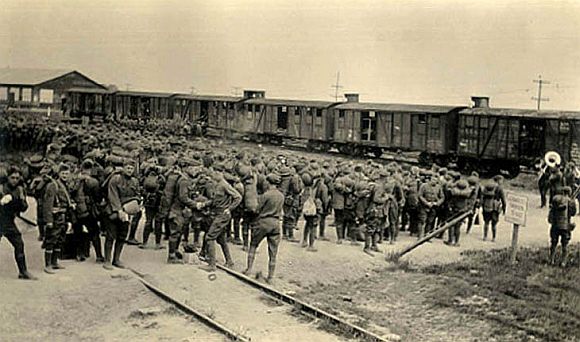Britain and France, exhausted after three years of war, were in urgent need of manpower, technical support, and supplies. As soon as America decided to enter the war, he two allies [actually associated powers] immediately pressed the U.S. to send engineers. By June 1917 an initial complement of American troops, plucked from duty along the Mexican border, was on its way to Europe as the American Expeditionary Forces (AEF), with Gen. John Pershing in command. By August, nine newly organized engineer railway regiments and the combat engineer regiment of the 1st Division had crossed the Atlantic. Several of the railway units were assigned to British or French formations pending the arrival of more American combat troops. By June 1918, 10,000 American soldiers were arriving in France daily.
The AEF, eventually numbering over two million men, needed to be transported, sheltered, and supplied—a job for the engineers. The hastily organized and trained army engineer regiments were the first to recognize the massive scope of the effort needed to support the AEF, and there was much to learn about the engineering needs of a modern army on a battlefield thousands of miles from home.
During the war, army engineers built port and railway facilities, roads, and bridges essential to moving troops and war materiel across France. They harvested timber and prepared lumber at 107 sawmills to build docks, storage depots, barracks, and hospitals. They operated searchlights for anti-aircraft defense, produced camouflage materials, and created millions of maps. While many of these activities took place behind the lines, army engineers also engaged in combat along the western front, often fighting as infantry in both defensive and offensive operations. All in all, around 240,000 American army engineers served in Europe during the war, of which approximately 40,000 were African American.
For army engineers, World War I was trial by fire. They had had little experience in mechanized warfare or in supporting a large expeditionary force fighting so far from home. The training manuals of the time described what had to be done but offered little guidance on how to do it, in the worst weather imaginable, and within range of a deadly enemy. So the officers and men of the engineer units learned their trade on the job, and whether they were builders or fighters, the engineers in the Great War met the challenges. They combined courage under fire with critically needed technical skills, and their contribution was essential to the success of the U.S. Army in the First World War.
Source: U.S. Army Corps of Engineers




My father was part of the combat engineer unit of the AEF 1st Division that crossed the Atlantic in August 1917. While he wrote about preparing the terrain for battle, he learned early on to put down the shovel and pick up the rifle to enter into combat. He wrote mainly about his experiences in battle.
ReplyDeleteEarly in the war, the engineer units assigned to infantry divisions were used quite often as replacements and fought along side their infantry brothers. See: http://www.2nd-division.com/_div.misc/chateau.thierry/belleau.engineers.htm
ReplyDelete